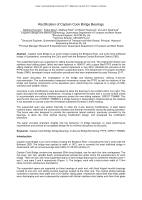Bridges

- Publication no: ABC2017-097-17
- Published: 26 April 2017
- PDF (free) Download
Captain Cook Bridge is an iconic bridge crossing the Brisbane River, and is the most trafficked bridge in Queensland, connecting the City’s south with the Brisbane Central Business District (CBD).
The suspended spans are supported on sliding knuckle bearings at one end. The original DU Glacier and stainless steel sliding plates, failed and were replaced in 1996-97, with a glass filled PTFE sheet for the sliding material. After 20 years of service, routine inspections in July 2016, identified the extrusion of the PTFE sheet from the bearings on the southern suspended spans. The Department of Transport and Main Roads (TMR), developed unique rectification procedures that were implemented by early February 2017.
This paper discusses, the investigation of the bridge and bearing behaviour utilising in-service instrumentation. The instrumentation measured movements across the PTFE as well as rotations of the bridge and bearing components at the expansion joint, determining the response to a range of traffic scenarios and weather events.
Innovative in-situ modifications were developed to allow the bearings to be rectified within one night. This paper discusses the bearing modifications, including a replacement knuckle with a curved surface aimed to accommodate non-uniform bearing pressures across the new sliding material, ORKOT TXMM®. This was the first trial use of ORKOT TXMM® in a bridge bearing in Queensland, implemented as this material is not expected to extrude under the immediate substantial increase in traffic loading.
The suspended span was jacked internally to allow the in-situ bearing modifications. A steel lateral restraint brace, restrained the construction stresses and thermal movements during the jacking operation. This brace was also designed to provide the operational lateral restraint, previously provided by the bearings, to allow the most optimal bearing modification design, and accelerate the rectification procedure.
The paper provides important insights into the behaviour of bridge bearings, to meet performance requirements and achieve an acceptable design life to minimise disruptions to the public.
